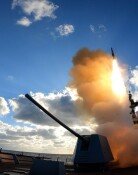Squeezed Between China, Europe
The Chinese shipping industry is growing. It recently overtook the Korean shipping industry in bulk freight and container freight.
On the other hand, the Korean shipping industry is losing ground by being squeezed between the Chinese shipping companies and large European ones.
In 2005, the Korean shipping industry was the third most export-driven industry in Korea, making $19.1 billion from exports behind the semiconductor industry ($30 billion) and the automobile industry ($27.2 billion). Given this, if the current situation continues, the industrys slump is likely take a toll on the Korean economy as a whole.
Two Chinese shipping companies, ranked sixth and seventh in the world, are overtaking Korean companies-
AXS-Alphaliner, a worldwide shipping intelligence firm based in France, said on February 6 that two Chinese shipping companies, China Shipping and Cosco, ranked sixth and seventh in the world in terms of cargo capacity by recording 406,000 TEUs and 390,000 TEUs, respectively. China Shipping posted 24.5 percent annual growth and Cosco grew by 10 percent annually between 2000 and 2006.
On the other hand, Koreas Hanjin Shipping Co., Ltd. slipped to eighth from fourth, recording 5.2 percent growth, nearly half the world average growth rates of 12.5 percent, during the same period. Another Korean shipping company, Hyundai Merchant Marine Co., Ltd., dropped from 15th to 18th place in the ranking. These two had 349,000 TEUs and 168,000 TEUs, respectively, last year.
From a humble start with only 15 liners in 1997, the state-owned China Shipping has grown at a rapid pace into a company with about 260 liners in 10 years. Protected by the Chinese government, the company has expanded by purchasing liners in large numbers with the $1 billion it earned by going public in 2004 in Hong Kongs stock market.
China Shipping possesses the newest liners among the 10 major shipping companies in the world, and it is setting a goal of becoming one of the worlds five biggest shipping companies by 2010.
Cosco achieved last year three consecutive annual net profits of more than 10 billion yuan (about 1.2 trillion won).
Sales increased, but profits decreased-
Korean shipping companies, however, had a bad year in 2006. They worked hard as usual but their profits dropped.
Hanjin Shipping and Hyundai Merchant Marine posted 6.0 trillion and 4.7 trillion won of sales, respectively, an 8.7 percent and a 5.3 percent increase from the previous year.
But they didnt make much profit. Hanjins operating profits last year were 149.1 billion won, only a quarter of the profits (572.8 billion won) it posted in 2005. For the same period, the operating profits of Hyundai plummeted to 97.1 billion won from 466.4 billion won.
Facing competition from the worlds three biggest shipping lines, the Maersk Company, MSC and CMA-CGM, which expanded through mergers and acquisitions (M&A), and Chinese companies, Korean companies decided to lower the unit price of the shipping charge. It dealt a serious blow to them.
Setting Korean shipping companies apart from others by improving services they provide-
Korean shipping companies attribute the current hardships they are suffering to the management environment that has changed since the Asian financial crisis between 1997 and 1998. One of the companies pointed out, During the financial crisis, we werent able to order new shipping liners and were forced to sell some of the liners we had to meet the 200 percent debt ratio the government required.
Experts advise that Korean shipping companies should expand more and provide services that set them apart from others to make much-desired profits, distancing themselves from the Chinese shipping liners.
Hwang Jin-hee from the Korea Maritime Institute said, Korean companies should improve the quality of their services to get shippers to turn to them rather than to Chinese companies despite high charges.
bell@donga.com changkim@donga.com







